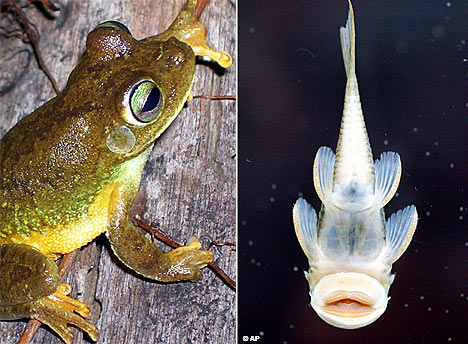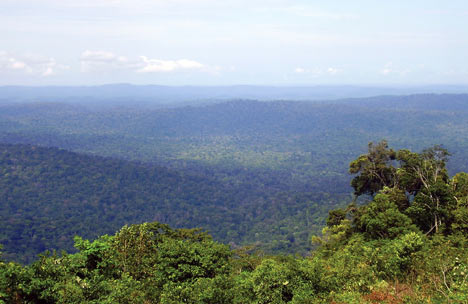tags: purple frog, Suriname, amphibians, Atelopus
A purple fluorescent frog of the genus Atelopus was discovered during a follow-up survey of the Nassau plateau in mid 2006 by Surinamese scientists Paul Ouboter and Jan Mol. The frog is one of 24 new species found in the South American highlands of Suriname, conservationists reported on June 4, 2007, warning that these creatures are threatened by illegal gold mining.
Image: Paul Ouboter
When scientists investigate new areas of the wilderness, they often discover insect species that are new to science, but last year, a group of researchers went in to the highlands in the South American country of Suriname and found 24 new species of animals, including a spectacular fluorescent purple frog in the genus Atelopus. The frog's skin is covered with irregular fluorescent lavender loops over a background of aubergine, which is the deep reddish purple-brown color of aubergines (eggplants).
"When you go to these places that are so unexplored and so remote, we do tend to find new species ... but most of them are insects," said Leeanne Alonso of Conservation International, who led the expedition that found the new species. "What's really exciting here is we found a lot of new species of frogs and fish as well."
In addition to this purple frog, the survey team, comprised of 13 scientists, also four other new frog species, six species of fish, 12 dung beetles and a new species of ant in Suriname's Nassau plateau and Lely Mountains. These creatures were discovered in a region about 80 miles (130 km) southeast of Paramaribo, which has enough clean and fresh water to support abundant fish and amphibians.
The team observed 467 species at the two survey sites, such as large cats like panthers and pumas, monkeys, reptiles, bats and insects. They also saw 27 species native to the Guayana Shield region, which spreads over Suriname, Guyana, French Guiana and northern Brazil. One of these was the rare armored catfish (below), which conservationists feared was extinct because gold miners had contaminated a creek where it was last seen 50 years ago.
The survey was funded by BHP Billiton Maatschappij Suriname (BMS, a subsidiary of BHP Billiton) and Suriname Aluminium Company LLC (Suralco, a subsidiary of Alcoa Inc), to provide information about the biodiversity and conservation value of potential future bauxite mining areas.
These highland areas will most likely not be mined in the future, said Alonso, at least not by the two mining companies that sponsored the study.
"It's an opportunity now for all the players, the mining companies who still have mining concessions there, the local communities, the government, the NGOs (non-governmental organizations), to try to make a regional plan for the area," Alonso said.
A Eleutherodactylus frog and a Guyanancistrus fish. The dwarf catfish, likely to be unique to the eastern plateaus of Suriname, is called "big mouth" by its discoverers due to the unusually large size of its mouth.
Image: Jan Mol.
Sources
Reuters (images, quotes)
DailyMail (images, quotes)
- Log in to post comments





What, no picture of the frog fluorescing?
you need to turn on the black lights for them to fluoresce!
Possibly they meant to write "day-glo" there?
Or just "bright" perhaps.
http://www.conservation.org/xp/frontlines/2007/06040701.xml
has more.
This hits very close to home for me. I was raised in Suriname and Paul Ouboter is my former Zoology professor. The pictures are making me home sick.
Oh wow wow wow¡
This fish is nearly the same what i collected when was an student (in Cuenca Ecuador)¡
Grrlscientist, have you some adresses to contact with the discoverers?
Can a muntjack deer that has the same number of chromosomes as a human, possibly produce offspring using a human egg and a muntjack deer sperm (or vise versa)?
It is interesting that two active bauxite mining companies financed that project. It is to be hoped that they will be more environmentally responsible than the freelance miners in the area. The original stream that the rediscovered Hartiella crassicauda was first found in has evidently been spoiled by run off from gold mining.
I'll think about that area the next time I have a choice of tossing a pop can in the garbage or a recycle bin.
I love the title: "Psychedelic" :)
Beautiful!
The fish apparently isn´t a Guyanancistrus but a Hartiella, still rarer.....